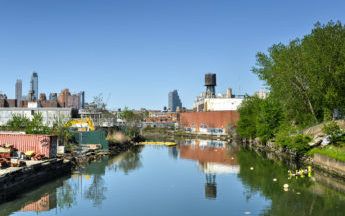Landmarks Commission Designates New Landmarks in Gowanus
By Penny Laughlin
The New York City Landmarks Preservation Commission (LPC) recently designated five historic structures in Gowanus as individual landmarks, citing the industrial buildings as representing the area’s most “architecturally distinctive” and “historically significant” properties. LPC selected the sites in collaboration with the Department of City Planning, the community, and other stakeholders.
The selected properties reflect the history of Gowanus, which became a center of industry and commerce following the completion of the Gowanus Canal in the 19th century. The new landmarks—manufacturing and industrial facilities constructed between 1884 and 1913—are all prominent structures that have adapted over the years to changes in economic activity and in the surrounding neighborhood.
- Located at 238-246 3rd Street, the Somers Brothers Tinware Factory originally housed Somers Brothers, the nation’s first known tinware lithographers. The company merged in 1901 with the American Can Company, which was once the world’s largest producer of tin cans. Now known as Old American Can Factory, the site has served as artists’ studios since the 1970s.
- The Brooklyn Rapid Transit Company (BRT) Central Power Station Engine House was built at 153 2nd Street in 1901-03. The power station consolidated operations for the borough’s multiple mass-transit lines, a significant step toward creating an integrated mass-transit system. The site ceased operations in 1972. The Powerhouse Environmental Arts Foundation acquired the property in 2012, planning to convert the structure into an arts center and industrial workshop.
- The Gowanus Canal Flushing Tunnel Pumping Station and Gate House at 196 Butler Street was finished in 1911 to clean the polluted Gowanus Canal. After the propeller mechanism broke in the 1960s, the Department of Environmental Protection (DEP) launched a five-year renovation and reactivated the pumping station and gate house in 1999. The property remains largely unchanged and pumps more than 250 million gallons of bay water into the Gowanus Canal every day.
- Situated at 170 2nd Avenue, the Monauk Paint Manufacturing Company Building was built in 1908. The property’s name refers to its initial tenant, a leading manufacturer of the early 20th Norge Sailmakers later occupied the space, manufacturing sails and covers for pleasure crafts until 1952. The highly intact factory building, with a “simple yet refined design,” reflects the neighborhood’s industrial history.
- The ASPCA Brooklyn Office, Shelter and Garage at 233 Butler Street was built as the borough’s dog and cat shelter for the American Society for the Prevention of Cruelty to Animals. The shelter opened in 1913 and operated until 1979. The neo-Romanesque design of the façade conveys the ASPCA’s civic and social significance.


